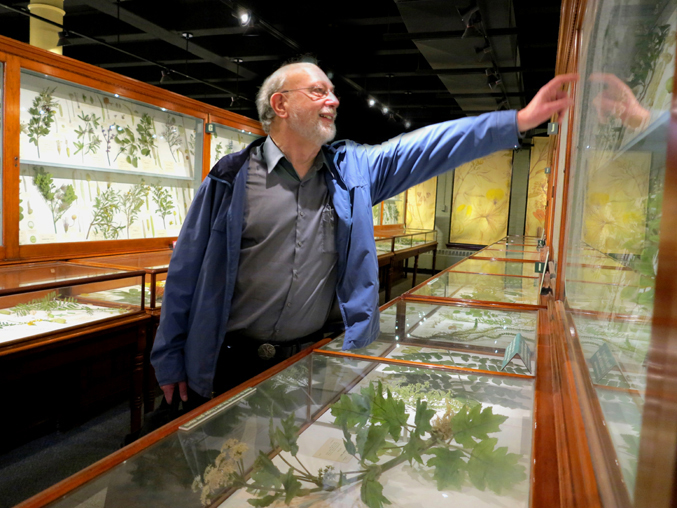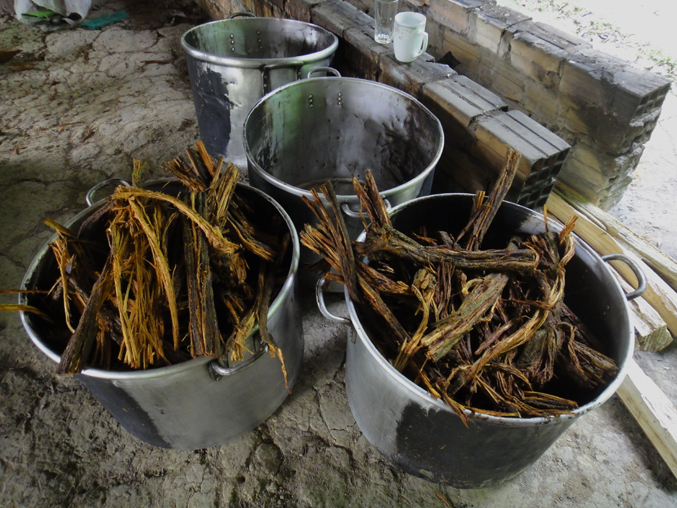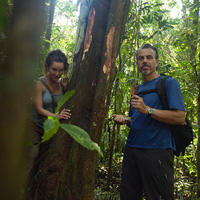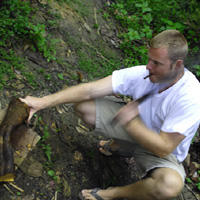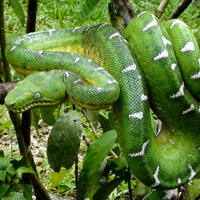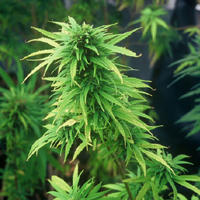Dennis McKenna Harvard Museum of Natural History Glass Plants. Photo by Zoe HelenePhoto by Zoe Helene
Celebrity ethnobotanist and ethnopharmacologist Dennis McKenna and his late brother, Terence, began their lifelong curiosity-driven quest for exotic hallucinogens in Amazonian jungles in 1971. Terence, a leading authority on shamanism who was known as the “Timothy Leary of the ‘90s,” chronicled the so-called “experiment at La Chorrera" in his book True Hallucinations (Harper San Francisco, 1993), and Dennis tells the full story in his newly published memoir, The Brotherhood of the Screaming Abyss: My Life with Terence McKenna (North Star Press).
I recently met Dennis McKenna at the Harvard Natural History Museum to view the Glass Flowers exhibit. During our walkabout, McKenna pointed out psychoactive and psychedelic plants and shared his insights about the sacred healing plant ayahuasca, “La Medicina”.. McKenna is one of the world’s foremost experts on the South American hallucinogenic beverage prepared from the bark of the Banisteriopsis caapi vine and the leaf of Psychotria viridis, (often called chacruna) that is used for healing in shamanistic ceremonies. People from all over the world and from all walks of life are heading down to the Peruvian Amazon to experience the consciousness-expanding journey of ayahuasca.
You first saw these glass flowers (lifelike botanical models made entirely of glass) in 1974?
I saw them in ‘74 when I first made a pilgrimage to visit R.E. Schultes at Harvard, so the glass flowers became emblematic of my visit to Schultes. I made a point to go see them on every subsequent visit.
Schultes looms large in your book. Why is he so important?
R. E. Schultes is a god, in fact. Andrew Weil and Wade Davis were two of his notable students. He’s sometimes called the Father of Ethnobotany, and he was the director of the Harvard Botanical Museum for many years. Schultes was known mainly as the world’s expert on hallucinogenic plants, but he was also known for his expertise on rubber and orchids. He spent thirteen or fourteen years continuously in the Amazon.
In his field research, didn’t he conduct bio-assays—trying plant remedies on himself?
Oh yes, he tried them. But he was very quiet when he was at Harvard—very straight-laced. He studied ayahuasca from his earliest days in the Amazon, in the ‘30s and ‘40s and he claimed that he tried all these things, but all he’d ever say was that he “saw colors.”
Tell me about your own research with ayahuasca?
I went through a lot of different phases with my scientific and professional ambitions to make ayahuasca an object of study. The chemistry, pharmacology and ethnobotany of ayahuasca was the focus of my doctoral research and ever since has never been far from my scientific interests. For a long time I wrote proposals and lobbied to do an IND (Investigational New Drug Application), which you have to do if you want to do an FDA-approved protocol to conduct clinical investigations of a new medicine.
Unfortunately, the FDA makes it ten times harder to study botanical drugs than to study pharmaceutical drugs. The problem is quality control because you have to be able to quantify the doses and all that. Ayahuasca is doubly difficult because not only is it a botanical preparation, but it contains DMT, a Schedule I controlled substance.
You’re working to establish a center in Peru that could address this.
If we want to bring ayahuasca to the wider world, we have to publish in peer-reviewed journals. My idea is to set up a center in Peru, where we could actually do rigorous science. We could just step out of the whole FDA regulatory morass and work with physicians in the States to bring people with the right diagnoses down there and put them through maybe twelve to fifteen sessions and extended residential treatment. We’d have a medical doctor, a shaman and maybe also a psychologist or psychiatrist, keep careful notes, measure outcomes and publish in peer-reviewed literature.
Ayahuasca is illegal in the U.S. but legal in Peru.
We’re interested in bringing the benefits to people, but it may be that, with ayahuasca, the people have to go to the medicine.
Are other countries more accommodating?
Jordi Riba, a pharmacologist who has done a lot of clinical work with ayahuasca in Spain, where regulatory restraints are looser, has been able to get approval. He imports the brew from Brazil and freeze-dries it, then he can standardize it to what it is supposed to be for each of the active ingredients.
But I have to say, this is not ayahuasca.
How so?
Synthetics and freeze-dried ayahuasca lack the purging quality that can trigger that all-important “loosening” of mental and physical blockages that's often the first sign that the work has begun. Ayahuasca is one of those plant medicines, like bitters, that you have to taste to get the full effect. It starts working as soon as it hits the tongue.
I feel personally that purging, as in vomiting, is a part of the healing. In some ways ayahuasca is a “cathartogen” (causes a catharsis). Catharsis is like a spiritual shock that leads to a sense of renewal. I think that actual physical purging is linked to getting rid of bad energy that can take residence in the body as well as the mind.
Ayahuasca is a mystery. You can drink a tiny bit and have a huge experience and down a large dose and have a quiet experience.
And isn’t that strange? It doesn’t follow any of the rules. Es una medicina muy mysterioso!
I meet people who use the term “plant spirit” as a matter of course. Initially I thought they were all rather woo-woo, but as I met more brilliant, accomplished plant spirit thought leaders, my thoughts started to shift to, “What am I missing here?”
This is the crux of a lot of the questions about the nature of plant intelligence. The shaman would say, “Well, of course the world is permeated with spirits and non-human intelligences,” but the reductionist scientist will say, “This has to be part of my personality that has split off and is reflecting back on me. It’s all the self.”
Do these plant spirits have personalities?
A lot of people do have this experience, but when you get into the territory of these things having personalities—well, then the rational reductionist part of me says, “This is ridiculous; this is just an aspect and projection of your personality, and you’re reading it into yourself. Your mind is creating this experience.” But the shamans, of course, will say it is not projection but personalities, intelligences, and they will ask, “Why do you need to over-analyze it, you Western gringo dog? Just take it for what it is!”
My father is a scientist, so I grew up with that “reductionist” way of thinking.
All these reductionists that say, “That’s ridiculous! Plants can’t have nervous systems; they don’t have brains!” Well, I say they have a serious lack of imagination.
Has your father ever taken psychedelics?
Oh no. No, no, no.
He’s got to put that on his map. He’s a scientist. He is obliged to do that before he can say anything else about it. It’s like making a pronouncement about telescope optics without having looked through a telescope.
My father is concerned about what he calls “losing touch with reality.”
That’s a conversation you have to have with your father. Reality is just as much a hallucination as any drug-induced experience. We know this.
Where do you think visions and other realities come from?
I think I don’t know. At some level everything is the self. We’re immersed in this hallucination that our brains are generating all the time. Ayahuasca and other psychedelics seem to open the portals to a realm where you interact with non-human intelligent entities who teach you things. Are they “real?” Definitely—in that you experience them, and in some sense anything you experience is real.
Are they constructions of your own brain/mind without any objective existence off in some “weird entity zoo” somewhere? That's where it gets tricky. Part of the challenge for science—and really I think this is the big challenge for neuroscience in this century—is to devise an experiment or a hypothetical construct that will enable this question to be answered. Definitive evidence of a non-human realm of intelligent entities would hands-down be the greatest discovery ever made.
But you don’t believe it’s “all in our heads?”
I do not think that the brain entirely generates them. I think that consciousness is a primary part of the structure of reality, and I think that our brains are as much detectors of consciousness as they are generators of consciousness. So consciousness is a property of the continuum. It’s like part of the quantum foam. In this world of illusion, the brain is essentially a very sensitive channel tuner, and you can encourage different states of consciousness by taking different drugs or practicing different types of mental disciplines.
So, do the plants speak to us?
You do get this sense and of an “I/thou” kind of dialogue.
I know other animals have consciousness we don’t understand and communicate with each other in ways we don’t understand. So why not plants?
Plants communicate with everything in their environment through chemical messengers. Their language is chemistry—the molecules and compounds that we value as drugs and medicines and fragrances. The way that they present to communicate with a fungus in the soil that they want to form a symbiotic relationship with, for instance, will be different from a hairless upright primate that may want to eat them.
Like us.
Probably the plant, in its effort to be versatile, is thinking, “Well, I’m talking to these hairless, upright primates so I probably need to present to communicate as something like them”—very much like many of the aliens in the movies, until they pull the mask off… and then!
They’re shape-shifters.
They are.
Just for fun then, I would like to hear your take on ayahuasca’s plant spirit personality.
Ayahuasca is almost always experienced as feminine. I don’t know anyone who experiences it as masculine. She is not a young woman. Ayahuasca is like hanging out with a wise grandmother who is much older, and much wiser than you. She’s more like your grandmother when you’re about eight years old and sitting on her lap looking up at her and you’re just in awe with this entity that’s so, so ancient and full of wisdom and stories and love.
In my experience, ayahuasca is only a loving spirit.
Ayahuasca is like hanging out with someone who has so, so much more experience than you do and who has your best interests at heart. She loves you, but she won’t hesitate to slap you upside the head if that's what you need!
So she’s feminine. But then sometimes in visions you’ll meet distinctly male or female entities.
Yes, but visions are the way the plant presents itself to you. The psychedelic plants—ayahuasca especially—present themselves as teachers. They will say, “I’m showing you this,” and you will experience a vision, and in that vision there may be a male or female figure or an animal—or anything. The plant spirit and the visions through which the plant teaches us are different.
Do you have any concerns with ayahuasca becoming so popular?
I don’t see the rise in ayahuasca tourism as a negative. People go down there looking for a genuine experience. They are not thrill seekers, by and large. They want to connect with the divine.
You can argue—and I think it’s true—that if it weren’t for ayahuasca tourism, the tradition would have died out. It was definitely on the wane, and it’s made a comeback—but at what price? Now shamans are catering to Western tastes. This new form of vegetalismo being created for the touristas is just a phase in the co-evolutionary relationship that we’ve had with these plants for thousands of years.
The psychedelic experience is different for everyone, isn’t it?
Nobody can have your psychedelic experience for you; you just have to screw your courage up and raise the cup to your lips or smoke the pipe or whatever it is and face what’s in there.
When was the last time you "nailed" it?
I’m not even sure what to answer about this—I nail it every day! I guess maybe last week’s interview with Joe Rogan is a good example. They said we “knocked it outta the park.”
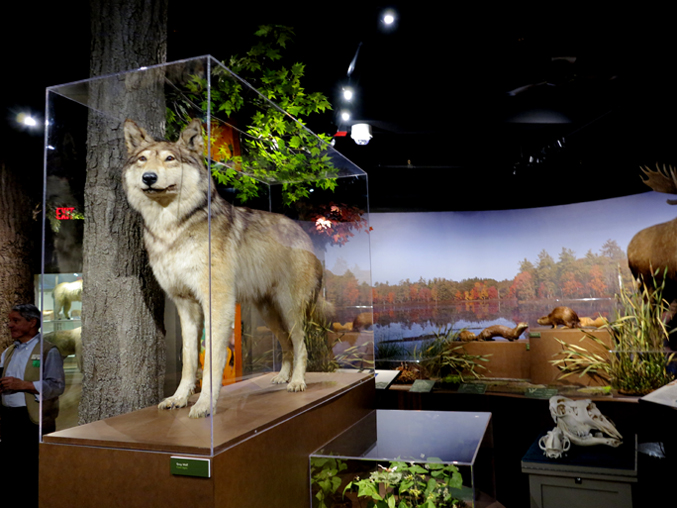
Wolves ♥ Special thanks to the Harvard Museum of Natural History for permission to photograph their extraordinary The Glass Flowers and New England Forests exhibits.
